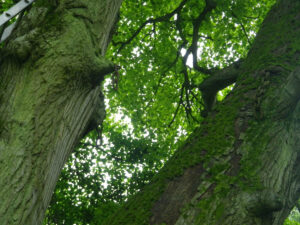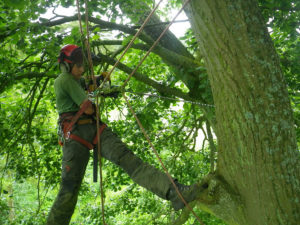As tree surgeons (or Arborists to give the correct term) we are often privileged to be asked to undertake some really interesting work. A particular example being at Hatherop Castle School when we were called in for tree surgery. We were tasked to replace a really old brace that had broken on a massive Silver Pendant Lime tree. The brace had been fitted years ago to help support the two main stems that were left vulnerable due to a large wound in the main fork.
This Silver Pendant Lime stands in the grounds of the school, forming part of a valued collection of trees. That’s where specialist tree surgery comes in and tree surgeon intervention was needed not only for safety reasons, but also to ensure that they maximise the likelihood of retaining this specimen tree for many years to come.

The old chain brace -snapped and half engulfed
When we first saw the tree we were fascinated by the old brace. It had been constructed of heavy-duty chain wrapped around both the stems to create a supplementary support to the weakened main fork. We have no idea how the wound in the main fork had originally occurred, as it dates back too many years to tell and could have resulted from quite a number of scenarios. What was clear however, was that at some point in the past, someone had been concerned enough to fit these chains to offer the tree some support and reduce the chance of a catastrophic failure.

The tree gradually encompasses the old chains and half engulfed
As the years passed, the old chains had been gradually absorbed by the ever-expanding stems and in places the tree had grown right over the chains and hidden them from sight. As the stems continued to expand and the tree exerted more pressure from both incremental growth and movement, the chains finally snapped, no doubt also aided by the corrosion that had also taken place. Therefore, with an old wound in the main fork, a broken brace and evidence of the stems being particularly vulnerable, action was required sooner rather than later.
The replacement braces we were to install would be two steel cables, fastened to bolts that would pass right through the tree (above the main stems). The idea is not to take the load off the stems (the tree needs to do this), but to act as a supplementary support as part of the tree’s dynamic structure. Although the steel cables will last for many years, the tree will still require periodic inspections from a tree surgeon to check on its health and structural condition and to spot any early signs of potential problems. Checking the cables should be part of the inspection.

Steve in the tree with the cables
Luckily the day I was on site to install the new braces the weather was kind to us. Cable bracing is not a job for a cold or wet day, as it involves a lot of sitting around in a harness and not very much climbing around to keep warm! Ben Jones, one of our up and coming young tree surgeons was on site with me and he was looking forward to this job and to the opportunity of expanding his experience of cable bracing. Surprisingly, we don’t actually get to fit all that many cable braces so it takes a while for our tree surgeons to learn this part of the job.
The first job for Ben was to drill the holes through the stems where we had agreed to fit the through-bolts that would anchor the cable to the stems. This is the most awkward part of the job as it involves using a very long drill, powered by a chainsaw engine whilst sitting in a harness suspended on the end of a rope!

Ben drills a hole for the through-bolts
Whilst Ben drilled and prepared the holes for the through-bolts I made up the cable ends using cast steel threaded eyes and thimbles. These parts are used to form loops in the cable ends that allow the cable to be fastened to the bolts. Once these were made up I joined Ben in the tree to help him with assembling the cables. It’s much easier with two tree surgeons to install cable braces than it is with one, particularly long cables. Having two of us in the tree meant that we didn’t have to keep climbing from one side of the tree to the other during the installation.

Ben tensions a cable
Once the cables were in place, they had to be adjusted (with a special tool called a ‘Draw Vice’) to the correct tension. It’s important to get this bit right as too little tension means the cables won’t be effective and too much tension means the tree will be prevented from moving in a natural way, leading to lack of response growth (the tree’s only method of helping and supporting itself) and potentially total reliance on the cable. We have to remember, as mentioned before, that the cable need to be a supplementary support only.

Two cables both tensioned
Once the cables were installed and tensioned, the tail ends were cut to length and taped up to leave it looking tidy. A finished cable looks very neat and is surprisingly difficult to spot from ground level. So as you can imagine, it’s very satisfying for us as tree surgeons to be able to make a big difference to the long-term prospects of a magnificent tree such as this Silver Pendant Lime without having done anything as obvious as a crown reduction or branch removal. It makes quite a change from the things we do on a normal day and makes the job of a tree surgeon just that bit more satisfying!








